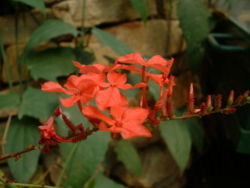Plumbago indica: Difference between revisions
No edit summary |
No edit summary |
||
| Line 1: | Line 1: | ||
{{Plantbox | __NOTOC__{{Plantbox | ||
| color = IndianRed | | color = IndianRed | ||
| common_names = Plumbago rosea, Scarlet leadwort | | common_names = Plumbago rosea, Scarlet leadwort | ||
| Line 14: | Line 14: | ||
| image_width = 250px | | image_width = 250px | ||
| image_caption = ''Plumbago indica'' | | image_caption = ''Plumbago indica'' | ||
| regnum = Plantae | |||
| divisio = Magnoliophyta | |||
| classis = Magnoliopsida | |||
| ordo = Caryophyllales | |||
| familia = Plumbaginaceae | |||
| genus = Plumbago | |||
| species = indica | |||
}} | }} | ||
| Line 20: | Line 26: | ||
''Plumbago indica'' has red or pink flowers which appear in the late summer.<ref>"Botanica. The Illustrated AZ of over 10000 garden plants and how to cultivate them", p 691. Könemann, 2004. ISBN 3-8331-1253-0</ref><ref name="Vermeulen 216"/> | ''Plumbago indica'' has red or pink flowers which appear in the late summer.<ref>"Botanica. The Illustrated AZ of over 10000 garden plants and how to cultivate them", p 691. Könemann, 2004. ISBN 3-8331-1253-0</ref><ref name="Vermeulen 216"/> | ||
{{Inc| | |||
syn. Plumbago rosea, Linn. (P. sanguinea, Hort.?). St. zigzag, more or less climbing, glabrous even in the inn.: lvs. large, ovate - elliptic, the short petiole somewhat clasping: fls. purplish red, in long racemes, the corolla- lobes little if any exceeding the exserted part of the tube, the calyx glandular-hairy; base of style hairy. s. Asia. B.M. 230. Var. coccinea, Hook. (P. coccinea, Salisb.), is a form with larger scarlet fls. B.M. 5363. Gng. 1:183. H.T. 11.6:292. This is the form chiefly cult. —Like P. capensis, this species is useful for summer bedding. It is also an excellent subject for winter blooming in pots. | |||
}} | |||
==Cultivation== | ==Cultivation== | ||
==Propagation== | ===Propagation=== | ||
==Pests and diseases== | ===Pests and diseases=== | ||
== | ==Gallery== | ||
==References== | ==References== | ||
| Line 51: | Line 43: | ||
*Flora: The Gardener's Bible, by Sean Hogan. Global Book Publishing, 2003. ISBN 0881926248 | *Flora: The Gardener's Bible, by Sean Hogan. Global Book Publishing, 2003. ISBN 0881926248 | ||
*American Horticultural Society: A-Z Encyclopedia of Garden Plants, by Christopher Brickell, Judith D. Zuk. 1996. ISBN 0789419432 | *American Horticultural Society: A-Z Encyclopedia of Garden Plants, by Christopher Brickell, Judith D. Zuk. 1996. ISBN 0789419432 | ||
==External links== | ==External links== | ||
Latest revision as of 19:51, 16 September 2009
Plumbago indica {{{latin_name}}}
|
Plumbago rosea, Scarlet leadwort
| ||||||||||||||||||||||||||||||||||||||||
|---|---|---|---|---|---|---|---|---|---|---|---|---|---|---|---|---|---|---|---|---|---|---|---|---|---|---|---|---|---|---|---|---|---|---|---|---|---|---|---|---|---|

|
|
| |||||||||||||||||||||||||||||||||||||||
| |||||||||||||||||||||||||||||||||||||||||
Plumbago indica, also known as Plumbago rosea or Scarlet leadwort, is a pot plant originally from India. It enjoys subtropical or warm-temperate climates, or a greenhouse in cool climates.[1]
Plumbago indica has red or pink flowers which appear in the late summer.[2][1]
| Standard Cyclopedia of Horticulture |
|---|
|
syn. Plumbago rosea, Linn. (P. sanguinea, Hort.?). St. zigzag, more or less climbing, glabrous even in the inn.: lvs. large, ovate - elliptic, the short petiole somewhat clasping: fls. purplish red, in long racemes, the corolla- lobes little if any exceeding the exserted part of the tube, the calyx glandular-hairy; base of style hairy. s. Asia. B.M. 230. Var. coccinea, Hook. (P. coccinea, Salisb.), is a form with larger scarlet fls. B.M. 5363. Gng. 1:183. H.T. 11.6:292. This is the form chiefly cult. —Like P. capensis, this species is useful for summer bedding. It is also an excellent subject for winter blooming in pots.
|
Cultivation
Propagation
Pests and diseases
Gallery
References
- Flora: The Gardener's Bible, by Sean Hogan. Global Book Publishing, 2003. ISBN 0881926248
- American Horticultural Society: A-Z Encyclopedia of Garden Plants, by Christopher Brickell, Judith D. Zuk. 1996. ISBN 0789419432